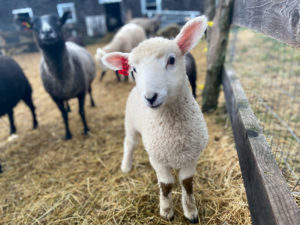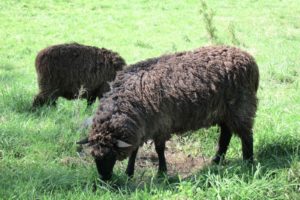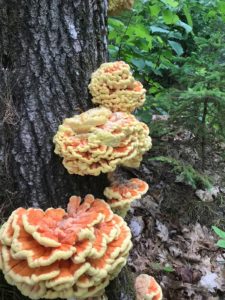This week we used meat from our old laying hens to make cat food for our two barn cats, Ailsa Craig (named after an onion variety that we grow on the farm) and Ruby Moon (named after a hyacinth bean flower variety). Ailsa Craig and Ruby Moon became part of the farm crew in summer 2016 to perform the very official and important task of rodent patrol, a job they relish and perform to a high standard. As a result of their presence, the mouse activity around the barn has nearly disappeared, and we brought in higher quality vegetable produce with less rodent damage this growing season. Given their obvious success at finding food, some folks ask why we would feed these excellent hunters additional food at all, but we’ve heard and found true that they hunt more prolifically for pleasure and not just survival when we provide them with the means towards a full belly.
So how do the laying hens fit into this story?

Our laying hens produce approximately one egg a day (technically, one egg every 26-plus hours) for their productive lives, but egg production decreases significantly after two years. Our two-year-old batch of 66 hens has lately been producing about six eggs daily, meaning that they’ve reached the end of their productive lives. At this point, we could let them live out their natural lives or send them to slaughter for food, but neither of these makes good economic sense: in the first case, we would give up valuable space and pay out significant feed costs for no output. Though we could eat them ourselves – old hen is delicious if slow cooked for a long time, given the toughness of the meat on a bird that’s been walking and pecking and foraging for a long life – the cost of slaughter is more than the collective value of the meat off our petite poultry.

Last year we landed on a third option, and we started slaughtering chickens with students and turning it into a nutrient dense homemade cat food for Ruby and Ailsa. Though it makes some people squeamish to talk about, I’ll admit that I very much enjoy slaughtering with students. We hold the animals on our farm with dignity through the whole of their lives, and it’s always felt unsettling that food safety legislation dictates that meat served through our commercial kitchen must be slaughtered at a USDA- or state-licensed facility. I understand – and appreciate! – the intention of that legislation from a food safety perspective, but I also believe in the power of engaging with the whole of our food system and taking responsibility for holding our animals with dignity through their deaths as well. Because these old laying hens are not for human consumption, we’re able to slaughter and process them on campus.

Over the course of Tuesday and Thursday work programs this week, twenty total students opted into the chicken slaughter work program. There were some grim faces and nervous giggles at the start, but inquisitiveness and intention and sheer awe won through in the end. (An aside: a student a few years ago wrote in a Literature and the Land paper about his process of learning to slaughter chickens from me. When I expressed interest in reading the piece of writing, he warned, “I may have overwritten you for dramatic effect.” After reading it, I laughed and agreed: his paper read, “I watched the innocence drain from Megan’s eyes as the knife glinted in the sun.” Hysterical.) Though I didn’t see innocence drain from anyone’s eyes during the process of the two-hour work programs, I did see students grapple with their role in taking the life of an animal, hold steadfastly to the birds as they died, treat the process with respect, and light up with questions as we eviscerated the animals. One particular highlight was finding eggs inside the birds: in the few that were still productive, we sometimes found one fully formed egg and then a line of yolks of various sizes: today’s egg, tomorrow’s, the next day’s, and so on, all the way back to a cluster of tiny pin-head sized future eggs.

On Friday work program, two students worked with Lisa Beneman, Farmer/Educator to make 450 cat food portions, which we lovingly call meat muffins, since we freeze them in muffin tins for easy access all winter. The cat food recipe is an adaptation from one published by the Feline Nutrition Foundation and includes chicken meat, heart, and liver, in addition to egg yolks, egg shells, and vitamins and minerals. Starting next week, we’ll add a meat muffin to the cats’ bit of dry cat food each day until the stock runs out, and they are bonkers for it. As soon as meat muffin season begins, Ailsa and Ruby are yowling at the door each morning when I wake up in the house attached to the barn.

One hundred new layer chicks arrived by mail six weeks ago and moved into newly-emptied coop after the slaughter wrapped up. And so the cycle continues.

I don’t say that callously or lightly: I steep in gratitude for the ways that energy cycles through this farm and for the interconnectedness of it all. We eat from this land in order to feed it with our tending and care, and the relationship between old hens and our cats is part of that extended process.













